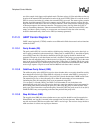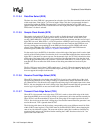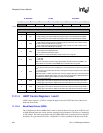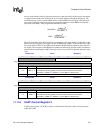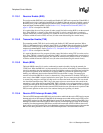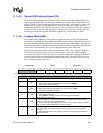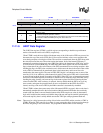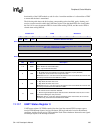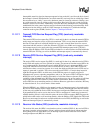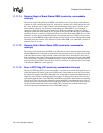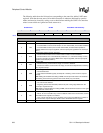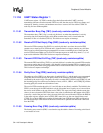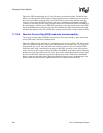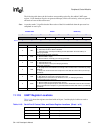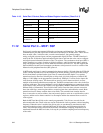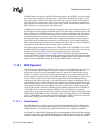
336 SA-1110 Developer’s Manual
Peripheral Control Module
Interruptible status bits signal an interrupt requested as long as the bit is set. Once the bit is cleared,
the interrupt is cleared. Read/write bits are called status bits, read-only bits are called flags. Status
bits are referred to as “sticky” (once set by hardware, must be cleared by software). Writing a one
to a sticky status bit clears it; writing a zero has no effect. Read-only flags are set and cleared by
hardware; writes have no effect. Additionally, some bits that cause interrupts have corresponding
enable/mask bits in the control registers and are indicated in the following section headings. Note
that the user has the ability to mask all UART interrupts by clearing bit 17 within the interrupt
controller mask register (ICMR). See the Chapter 9, “Interrupt Controller”.
11.11.7.1 Transmit FIFO Service Request Flag (TFS) (read-only, maskable
interrupt)
The transmit FIFO service request flag (TFS) is a read-only bit that is set when the transmit FIFO is
nearly empty and requires service to prevent an underrun. TFS is set any time the transmit FIFO
has four or fewer entries of valid data (half-full or less), and is cleared when it has five or more
(more than half-full) entries of valid data. When the TFS bit is set, a DMA service request is made.
An interrupt request is also made unless the transmit FIFO interrupt request mask (TIE) bit is
cleared. After the DMA or CPU fills the FIFO such that five or more locations are filled within the
transmit FIFO, the TFS flag (as well as the DMA and interrupt request) is automatically cleared.
11.11.7.2 Receive FIFO Service Request Flag (RFS) (read-only, maskable
interrupt)
The receive FIFO service request flag (RFS) is a read-only bit that is set when the receive FIFO is
nearly filled and requires service to prevent an overrun. The amount of data that causes RFS to be
set is nondeterministic. However, the range in which RFS will be set is guaranteed. RFS is set at
some point when the receive FIFO is one- to two-thirds full (or more). The UART’s FIFOs are
self-timed to reduce cost and save power. As a result, the depth at which the receive FIFO service
request is generated is variable. This is the reason the receive FIFO is 12 entries deep instead of
eight like the transmit FIFO. At which entry in the FIFO the request is actually triggered is
dependent on IC process, operating temperature, and so on. The receive FIFO is designed to signal
the RFS bit to be set when it contains eight entries of valid data. However, because of the
variability of the self-timed logic, RFS may also be set when seven, six, or five entries of valid data
are present within the FIFO. Likewise, under normal circumstances, RFS is cleared when the
receive FIFO has seven remaining entries of valid data. However, again due to variations, RFS may
be cleared when six, five, or four entries of data remain.
When the RFS bit is set, a DMA service request is made. An interrupt request is also made unless
the receive FIFO interrupt request enable (RIE) bit is cleared. Even though more than four entries
of data may exist within the receive FIFO, the user must configure the DMA burst size to 4 words.
If programmed I/O is used to service the receive FIFO, a maximum of 4 words may be removed
without checking if data is valid. After this point, the receive FIFO not empty (RNE) flag must be
polled before each read to see if more data remains. After the DMA or CPU empties the FIFO such
that five or more empty locations are available within the receive FIFO, the RFS flag (as well as the
DMA and interrupt request) is automatically cleared.
11.11.7.3 Receiver Idle Status (RID) (read/write, maskable interrupt)
The receiver idle status bit (RID) is set when the receiver is enabled (RXE=1), the receive FIFO is
not empty (contains at least one entry of data), and three frame periods elapse without any data
having being received. When RID is set, an interrupt request is made unless the receive FIFO
interrupt request mask (RIE) bit is cleared.



